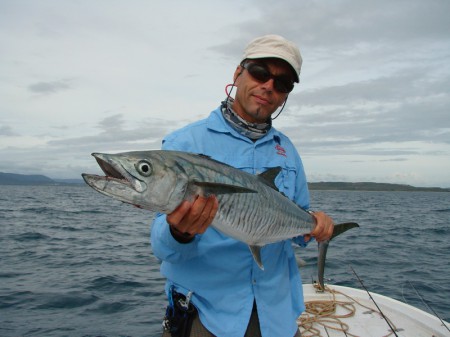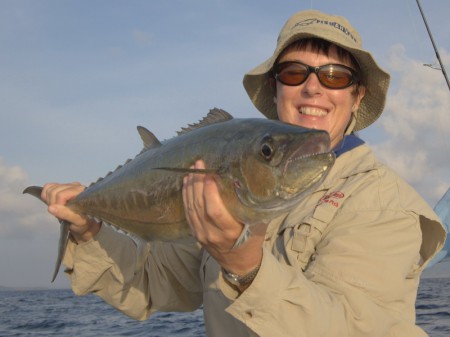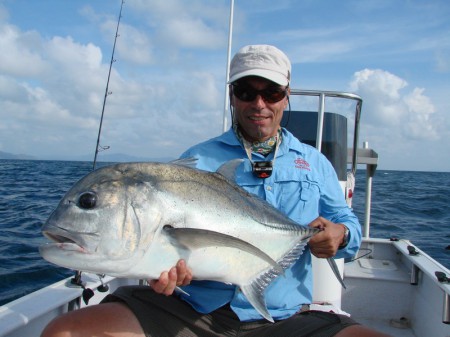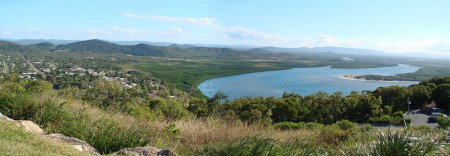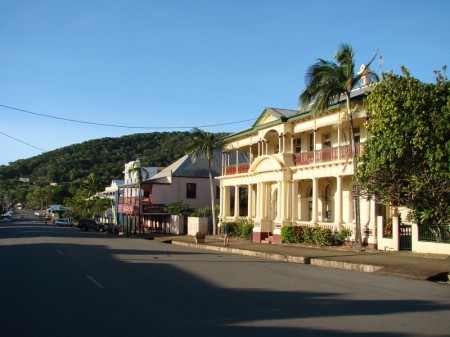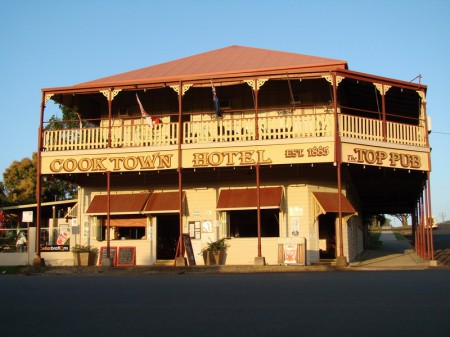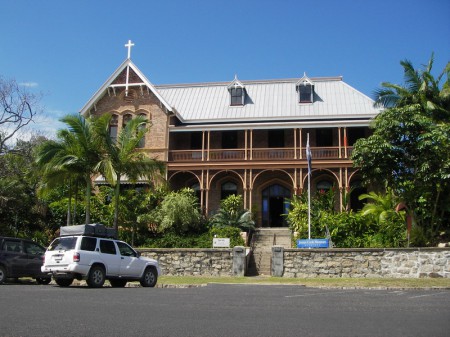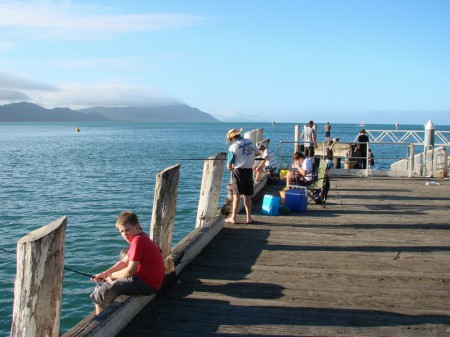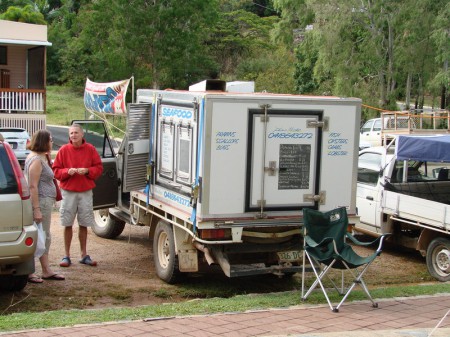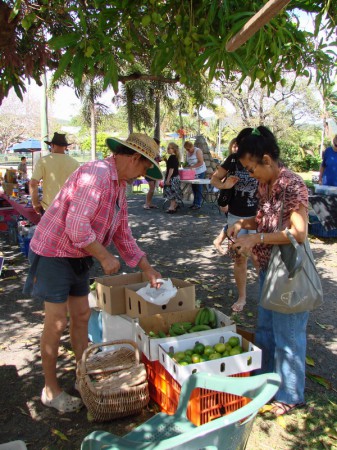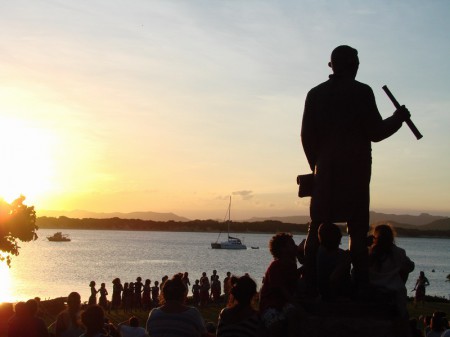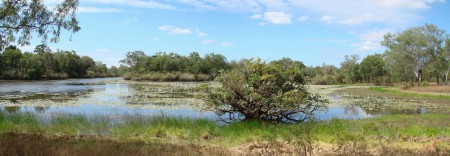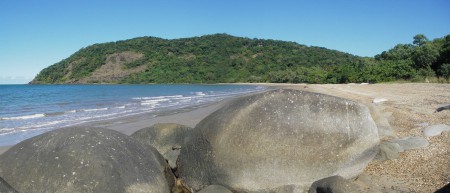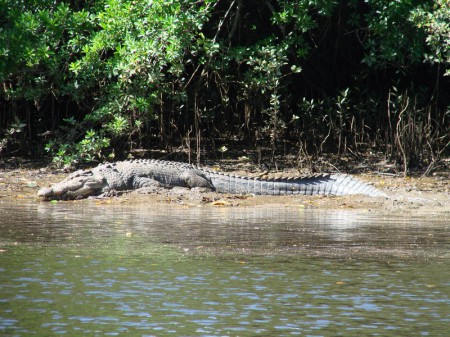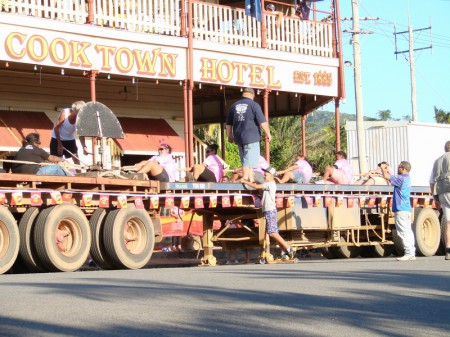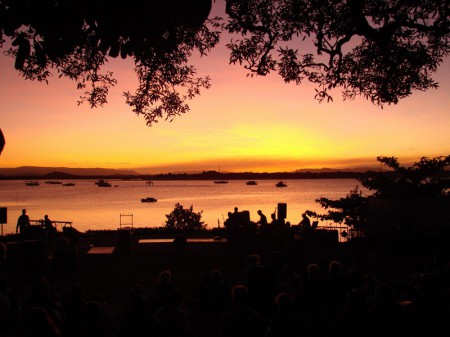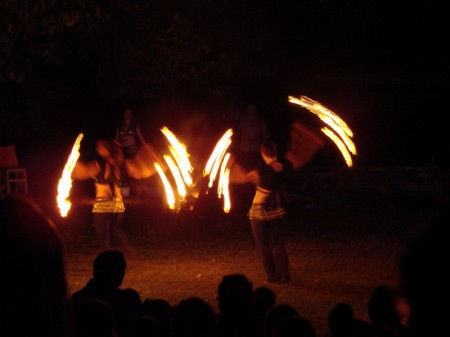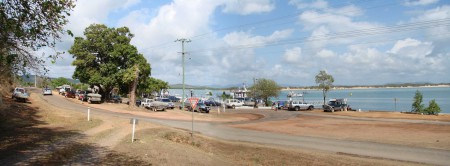Cooktown all sorts
To say it according to Garfield: There has to be more to life than fishing, but I can’t think of anything. So, if you like to wet a line, Cooktown is definitely a magic place to be.
No matter what time of the year, there is always some interesting fishing to be had somewhere close by. If it is too windy to enjoy one of the many reefs, you can seek shelter up the rivers and try to get a barramundi or a mangrove jack. Or fish from the famous Cooktown wharf of course, where many locals and visitors alike have caught their fish of a lifetime. The diversity of fishing and fish species on offer in Cooktown are absolutely amazing and it is possible to catch big giant trevally, spanish mackerel or coral trout out at the reef in the morning and to have a go at jungle perch in a tiny, crystal clear rainforest stream in the afternoon.
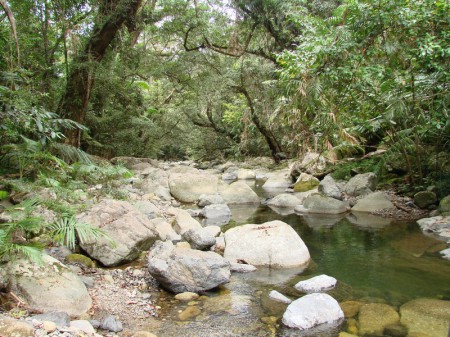
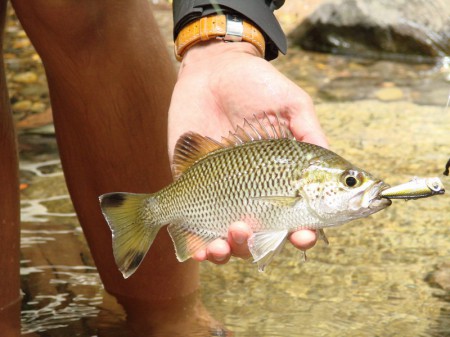
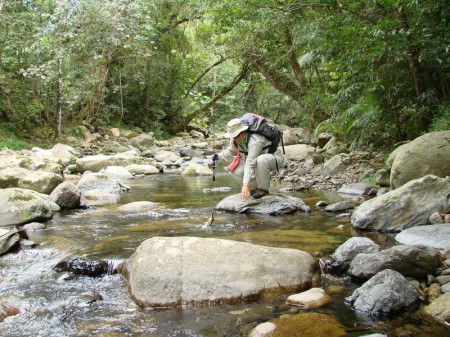 Early one morning, a remarkable trip led us south along the unsealed coastal road in search of jungle perch. Many of the small creeks south of Rossville are full of this great little native fish. Jungle perch only reach a couple of pounds, but their attitude would suit a giant. The creek we fished that day was cool and clear and reminded us very much of a mountain stream back home. Apart from the fact that it flows through dense tropical rainforest rather than alpine meadows. Big boulders formed the creek bed and the pools and rapids looked very fishy. The first cast with our light 1 to 3 kg outfit yielded a fish; the beautifully marked jungle perch took the little popper aggressively and gave a good account of itself. We kept catching fish on our surface lure while climbing up the creek.
Early one morning, a remarkable trip led us south along the unsealed coastal road in search of jungle perch. Many of the small creeks south of Rossville are full of this great little native fish. Jungle perch only reach a couple of pounds, but their attitude would suit a giant. The creek we fished that day was cool and clear and reminded us very much of a mountain stream back home. Apart from the fact that it flows through dense tropical rainforest rather than alpine meadows. Big boulders formed the creek bed and the pools and rapids looked very fishy. The first cast with our light 1 to 3 kg outfit yielded a fish; the beautifully marked jungle perch took the little popper aggressively and gave a good account of itself. We kept catching fish on our surface lure while climbing up the creek.
The only thing missing was a light, 7’ flyrod and a couple of bulky dryflies. Every now and then the surroundings detracted us from our task and we admired the rainforest. Orchids were flowering in many of the large trees and their sweet perfume filled the air. Tall tree ferns, palms, vines and countless other plants formed dense and lush green walls on both sides of the creek. We heard many different sounds and butterflies as large as a bird fluttered in patches of sunlight. By mid afternoon, we called it a day and prepared to walk all the way back to the car. Progress in the creek itself was very slow due to all the boulders big and small and when we crossed a small side stream, we decided to try and get up the stream to reach a track nearby.
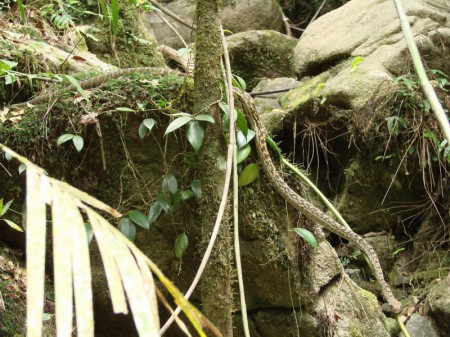
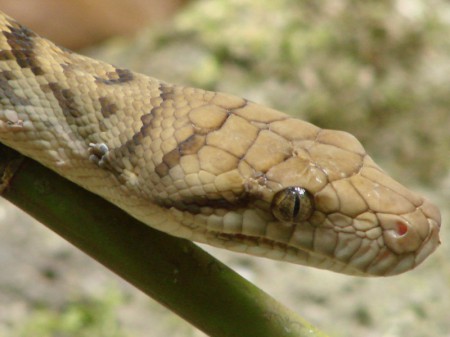 We climbed up the steep bank and when we peered over the edge, trying to find something to hold on and pull ourselves up, we looked into the eyes of a somewhat surprised amethystine python. The snake was resting on a large, mossy boulder, trenched in sunlight. With a length of about 3.5m it was impressive, but would grow a lot more before reaching its full size. Amethystine pythons are Australia’s largest snake and can grow to 6 meters. After a first fright, we quietly admired the reptile for a while, before continuing up the stream. We reached the track soon after and walking back to the car was a breeze.
We climbed up the steep bank and when we peered over the edge, trying to find something to hold on and pull ourselves up, we looked into the eyes of a somewhat surprised amethystine python. The snake was resting on a large, mossy boulder, trenched in sunlight. With a length of about 3.5m it was impressive, but would grow a lot more before reaching its full size. Amethystine pythons are Australia’s largest snake and can grow to 6 meters. After a first fright, we quietly admired the reptile for a while, before continuing up the stream. We reached the track soon after and walking back to the car was a breeze.
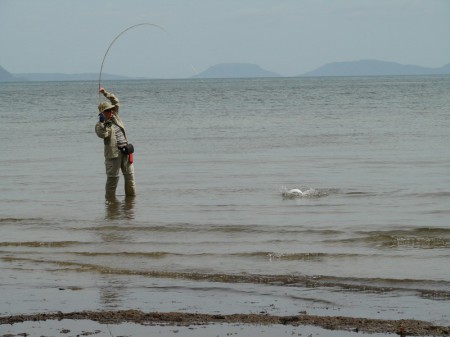 A friend had told us of some exciting fishing for tarpon along the beach and we were keen to have a go ourselves. The next morning, we left early to fish the incoming tide. While walking along the beach to where all the action was supposed to take place, we saw the turmoil from a distance. Small jelly prawns jumped out of the water everywhere and dorsal fins were breaking the surface at warp speed. Tarpon in a feeding frenzy!
A friend had told us of some exciting fishing for tarpon along the beach and we were keen to have a go ourselves. The next morning, we left early to fish the incoming tide. While walking along the beach to where all the action was supposed to take place, we saw the turmoil from a distance. Small jelly prawns jumped out of the water everywhere and dorsal fins were breaking the surface at warp speed. Tarpon in a feeding frenzy!
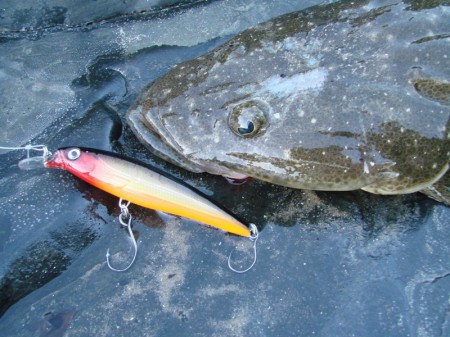 We rigged up our rods with shaking hands; one spinning rod with a small soft plastic and a fly rod with a floating line and a pink Crazy Charlie. The fish took the fly without much hesitation and stayed connected, but getting a decent hook up on the soft plastic was near impossible and we lost almost every tarpon. The Pacific tarpon looks exactly like its Atlantic cousin, but does not grow nearly as big; we caught fish up to 70cm. Every now and then a small giant trevally or queenfish took a liking for one of our lures and at some stage we even got a good flathead. After a little more than half an hour, the action slowed down and soon after the fish had all but disappeared.
We rigged up our rods with shaking hands; one spinning rod with a small soft plastic and a fly rod with a floating line and a pink Crazy Charlie. The fish took the fly without much hesitation and stayed connected, but getting a decent hook up on the soft plastic was near impossible and we lost almost every tarpon. The Pacific tarpon looks exactly like its Atlantic cousin, but does not grow nearly as big; we caught fish up to 70cm. Every now and then a small giant trevally or queenfish took a liking for one of our lures and at some stage we even got a good flathead. After a little more than half an hour, the action slowed down and soon after the fish had all but disappeared.
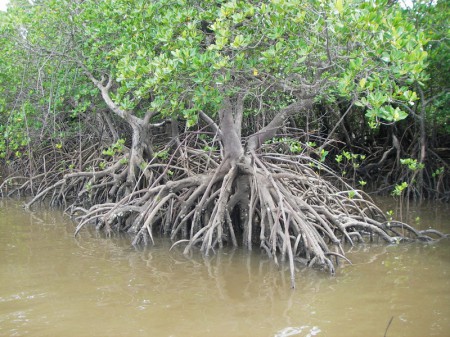
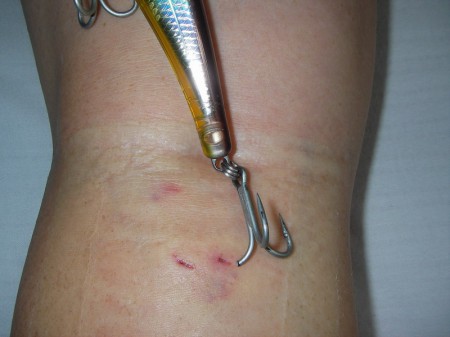 Fishing can be a dangerous pastime as shown on a beautiful day while up the river. We were casting to the bank and a big barra lure got caught in the mangrove roots at some stage. While applying a lot of pressure to get it off, the lure suddenly came free and shot back to the boat and hit Béatrice’s calf. One of the trebles firmly embedded itself in the muscle and it didn’t look pretty. We normally squash all the barbs on our lures, but the one in question was new and we forgot to do that. So it was packing up and heading back to the boat ramp and up to the hospital. The doctor on duty just smiled at us – this kind of hook up is fairly common around Cooktown – and after applying a local anesthetic, he cut the treble off and pushed the remaining point trough the skin and removed it. Only two tiny scars remain as an account of another day in paradise.
Fishing can be a dangerous pastime as shown on a beautiful day while up the river. We were casting to the bank and a big barra lure got caught in the mangrove roots at some stage. While applying a lot of pressure to get it off, the lure suddenly came free and shot back to the boat and hit Béatrice’s calf. One of the trebles firmly embedded itself in the muscle and it didn’t look pretty. We normally squash all the barbs on our lures, but the one in question was new and we forgot to do that. So it was packing up and heading back to the boat ramp and up to the hospital. The doctor on duty just smiled at us – this kind of hook up is fairly common around Cooktown – and after applying a local anesthetic, he cut the treble off and pushed the remaining point trough the skin and removed it. Only two tiny scars remain as an account of another day in paradise.
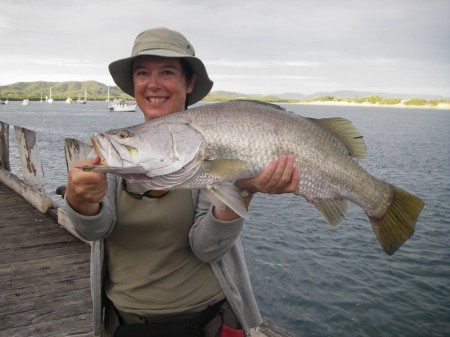 One of Cooktown’s icons and a great fishing spot is the wharf. In the tourist season, it can be a very busy place indeed and anglers are standing side by side to get their quarry. Because the wharf lies at the mouth of the Endeavour River and open water and reefs are so close by, you never know what you get next. Barramundi, spanish mackerel, mangrove jack and giant trevally are some of the more frequent species encountered, but there are many, many more. All sorts of creatures inhabit the warm tropical waters and people have caught sharks and rays from this amazing fishing platform.
One of Cooktown’s icons and a great fishing spot is the wharf. In the tourist season, it can be a very busy place indeed and anglers are standing side by side to get their quarry. Because the wharf lies at the mouth of the Endeavour River and open water and reefs are so close by, you never know what you get next. Barramundi, spanish mackerel, mangrove jack and giant trevally are some of the more frequent species encountered, but there are many, many more. All sorts of creatures inhabit the warm tropical waters and people have caught sharks and rays from this amazing fishing platform.
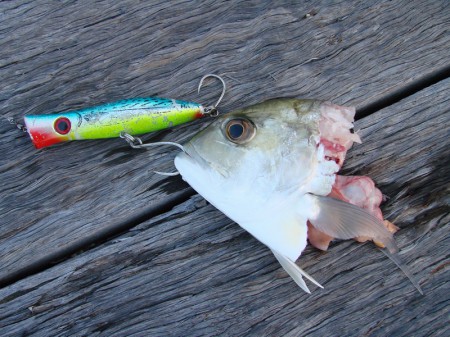 We had great times fishing there too and, apart from other species, caught some good barramundi. Hooking a fish while fishing from the wharf is one thing, getting it past the several huge resident Queensland groper is another.
We had great times fishing there too and, apart from other species, caught some good barramundi. Hooking a fish while fishing from the wharf is one thing, getting it past the several huge resident Queensland groper is another.
The groper with its huge bucket mouth – they can reach 360cm and 300kg – is able to swallow some pretty big fish. Several gropers reside right under the wharf at times and as soon as they detect a fish in distress, they go for it. We lost a Spanish mackerel and the brand new lure it had taken while trying to land it. One of the groper was faster and only with a lot of luck were we able to cut the heavy braided fishing line before our rod got pulled into the wharf.
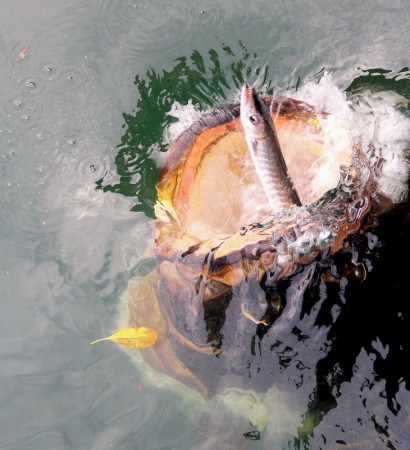 When we caught a barracuda one day, we thought it to be a good idea to feed it to the groper and take a picture of the action. The dead barracuda was tied to a 120lbs hand line and lowered into the drink. Seconds later the head of the groper appeared from under the wharf and we pulled the fish back up, out of the water. Everyone got ready with the camera and the barracuda was lowered again. Before it even hit the surface, the water exploded and the groper inhaled the 60cm fish with ease. The heavy nylon line snapped like a sewing thread and most of the bystanders missed the action completely. Not so Geoffrey! He got a great shot, not the first one by the way; he is a dedicated and talented photographer.
When we caught a barracuda one day, we thought it to be a good idea to feed it to the groper and take a picture of the action. The dead barracuda was tied to a 120lbs hand line and lowered into the drink. Seconds later the head of the groper appeared from under the wharf and we pulled the fish back up, out of the water. Everyone got ready with the camera and the barracuda was lowered again. Before it even hit the surface, the water exploded and the groper inhaled the 60cm fish with ease. The heavy nylon line snapped like a sewing thread and most of the bystanders missed the action completely. Not so Geoffrey! He got a great shot, not the first one by the way; he is a dedicated and talented photographer.
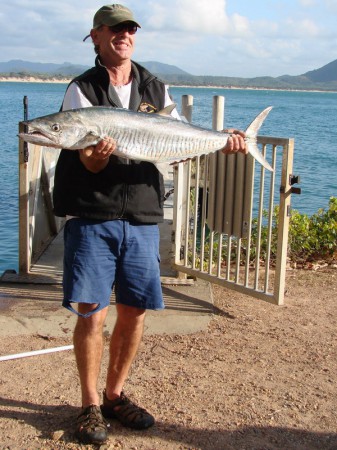 During and after the wet season, the fishing action turns crazy. Otherwise dry drains and culverts are suddenly full of water and full of fish and it is possible to see people standing along the highway and catching barramundi from the road. Nearby Lakefield National Park becomes a huge wetland and barramundi and crocodiles reign supreme. Cooktown truly is a fishing paradise!
During and after the wet season, the fishing action turns crazy. Otherwise dry drains and culverts are suddenly full of water and full of fish and it is possible to see people standing along the highway and catching barramundi from the road. Nearby Lakefield National Park becomes a huge wetland and barramundi and crocodiles reign supreme. Cooktown truly is a fishing paradise!
